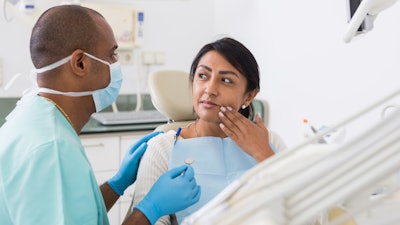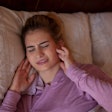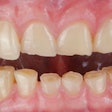
You are seeing a new patient today in your hygiene chair. She explains that she has been experiencing pain in her jaw when she eats, and her jaw is popping every now and then. She admits to using Dr. Google and thinks she may have temporomandibular joint (TMJ) disorder, but she doesn’t know what that means. What can you tell her?
What is TMJ?
TMJ is the temporomandibular joint, the joint that connects the temporal bone of the skull with the condyle of the mandible. Separating the two bones is a fibrous connective tissue, the meniscus or disc.
 Ann-Marie C. DePalma, CDA, RDH, MEd.
Ann-Marie C. DePalma, CDA, RDH, MEd.
In addition to the bones and disc, there are the muscles of mastication, ligaments, tendons, and nerves that stabilize, innervate, and allow for movement of the joint. When the disc is out of its natural position or there are issues with the musculature, pain and popping are often symptoms, but other issues can exist as well. TMJ issues can present with a variety of referred symptoms, including ear pain, headaches, neck, and throat pain.
Unlike most joints in the body -- for example with the knee, you can move the right knee without moving the left knee -- with the TMJ, both joints must move in unison. When there is a problem within the joint itself (bone or disc) or the muscles of mastication, pain and limited opening can occur.
Yet when a patient is told they have TMJ, that is not a diagnosis! TMJ is the joint itself, while the disease process is temporomandibular disorder (TMD). TMD can consist of a problem within the joint itself, the muscles that support the joint, or a combination of a joint or muscle problem. Determining the actual diagnosis determines the course of treatment. Airway issues and sleep apnea have also been associated with TMD.
A variety of diagnostic tools can be used to evaluate TMD. Initially, radiographs can be taken and range from a panoramic image to cone-beam computed tomography. The gold standard of imaging is magnetic resonance imaging (MRI). Standard imaging shows primarily hard tissue, while an MRI can show both hard and soft tissue.
Determining if the pain, popping, and limited opening are a result of a joint issue or a muscle issue, other types of diagnostic tools can be initiated. These can range from the following:
- Physical therapy or chiropractic analysis
- Doppler sound amplification
- Occlusal analysis
- Electromyography
- Muscle or joint injections, laboratory testing, or behavioral assessments
Some of the diagnostic tools can also be valuable treatment modalities as well, such as physical or chiropractic therapies or injections.
What comes next?
Once a precise diagnosis has been determined, treatment can commence beginning with placing the patient on a soft diet. Soft diets and limiting movement help with both joint and/or muscular involvement in relieving pain. From there, physical/chiropractic therapy; transcutaneous electrical nerve stimulation (TENS); injections, including Botox; nutritional and mental health counseling; various types of medications, including nonsteroidal anti-inflammatories or cannabidiol (CBD); and heat and/or ice can be utilized.
Appliance therapy has been used for years as the main component of treatment. Depending on the actual diagnosis, the practitioner's philosophy of treatment will determine the type of appliance the patient receives. These devices can range from hard to soft appliances, upper or lower appliances, or combination appliances. They can be flat plane or with ramps or other devices attached, worn 24/7, or only at specific times. No one type of appliance is the "perfect" appliance.
What causes TMD?
Whatever form of therapy is undertaken, TMD has many causative factors. These can range from the following:
- Malocclusion
- Developmental abnormalities
- Cervical/neck issues
- Postural habits
- Hormonal influences and even stress
Stress does not cause TMD, but it can be a contributing factor. Although TMD patients vary in age and gender, many TMD patients are women in their childbearing years. Research has shown that there are estrogen receptors in the joint, so hormonal influences may play a role.
With a variety of possible causes, a combination approach to treatment may be appropriate for some patients. For example, treatment may include physical and chiropractic therapy along with appliance therapy or Botox injections with stress management counseling.
TMD is a multifactorial disorder and has many ways of being treated. Some treatment methods have proven research backing the particular treatment, while others do not. A patient who is experiencing TMD should ask their provider how long and what type of patients they have treated and if they have treated their situation previously with what type of results.
If conservative treatment has not been successful, or if the treatment has lasted for about a year with no improvement, or if there have been bony changes seen on radiographs, surgery can be considered. Surgery, however, is considered a "last resort," with only about 10% of TMD patients requiring surgery.
As there are a variety of diagnostic and therapeutic tools available, so are a number of surgical options, including arthrocentesis, laser, arthroscopic, and open joint procedures. Yet with any surgical procedure, there are several surgical complications, including infections, malocclusions, nerve damage, and surgical failures. The goal of treatment is to provide the patient with a pain-free existence and friction-free movement of the joint and muscles.
Over the years, there have been a number of treatments that have proved to be harmful to patients. Understanding the full scope of the diagnosis and treatment are important for the patient to understand. Patient advocacy groups are available that help individuals understand the condition and that have helped advance the science and research regarding TMD and the TMJ itself. Providing education to patients so they understand their disease and educating ourselves as dental professionals helps ensure that patients receive the best care possible.
Ann-Marie C. DePalma, CDA, RDH, MEd, is a graduate of the Forsyth School for Dental Hygienists, Northeastern University, and the University of Massachusetts Boston. She is a fellow of the Association of Dental Implant Auxiliaries, a fellow of the American Academy of Dental Hygiene, a continuous member and fellow of the American Dental Hygienists' Association as well as a lifetime member of the American Association of Dental Office Management. She is the 2017 Esther Wilkins Distinguished Alumni of Forsyth Award recipient.
The comments and observations expressed herein do not necessarily reflect the opinions of DrBicuspid.com, nor should they be construed as an endorsement or admonishment of any particular idea, vendor, or organization.



















